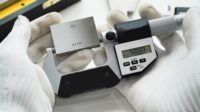Gage Pass/Fail Problems
Two tolerances should be shown for any gage you use.

I took a cursory look at this subject in a recent column but with the increasing number of companies expecting their calibration sources to make such decisions on their behalf, I thought a little more detail was in order.
When a calibration report shows the lab’s readings of size and the tolerances involved for such gages, for example, I couldn’t understand why the lab had to make the call in the first place. All the user had to do was compare the readings to the tolerances. On reflection, I realized that it saved the user of the report from having to justify decisions that could be questioned by an auditor. The tolerances on which the decision is based are what could be questioned so if they are on the report, an auditor is unlikely to question their validity.
Another reason prompting this requirement is that the gage user does not know how to determine what the tolerances should be so new equipment tolerances become the default values. This is incorrect when it comes to limit gages and many instruments and invariably results in perfectly serviceable equipment being called into question or outright rejected.
The way this should work is that you should have two tolerances shown on the record for any gage you are using. One is for the gage when it is new because that is what it is supposed to be at the beginning of its use and that’s the level of precision you are paying for as new. The second tolerance indicates how much wear you can tolerate on the gage before it is no longer suitable for your work. This decision is based on the tolerances you have to maintain in your work and how much of those tolerances you are prepared to give up for gaging or measurement of them. Many companies use ten percent of the work tolerance as an allowance for this. This a decision that can only be made by you since outside labs are not privy to this information or the conditions of use and the gage’s track record for wear.
If you know this information you can make the acceptance call and, more importantly, make changes if circumstances indicate they should be increased or decreased.
While the ISO 17025 standard does not require calibration labs to make these decisions, it does require that if this is done, how measurement uncertainty was applied to a decision on a report must be indicated on it. This is a call you have to make and you must advise your calibration source accordingly.
Simple pass/fail or ‘out-of-tolerance’ comments on reports are often generated by software the calibration source may be using and invariably this type of software makes a simple, clerical comparison you could do in your head as you read the report.
Irrespective of what rules are used by man or machine, pass/fail and similar comments are taken as gospel so when a fixed limit gage gets a ‘pass’ it is assumed that it is good to go when this may not be the case at all.
If the gage in question was a thread plug gage for example, the pitch diameter may have been calibrated and all the factors have been taken into account so it gets a ‘pass.’ But the functional pitch diameter may be quite different due to pitch (or lead if you will) variations which would make it a ‘fail.’ Most calibration facilities do not perform such calibration because they don’t have the hardware to do so or, more importantly, because the market won’t pay for it. Because of this, the ‘pass’ decision may be out to lunch.
Gage roundness is another element that is rarely calibrated due to market considerations that can cause similar incorrect decisions to be made. This can be a significant factor on plain gages as well as other geometrical variations in them.
If you want an outside source making these decisions on calibration reports, be aware of what can go wrong and ensure you clearly communicate your requirements to the laboratory and how the many factors involved in decision making are to be applied. Be aware that many labs will begin putting disclaimers regarding decisions on their reports to reduce their legal liability in making them.
Looking for a reprint of this article?
From high-res PDFs to custom plaques, order your copy today!






